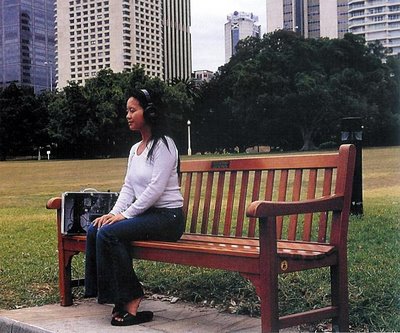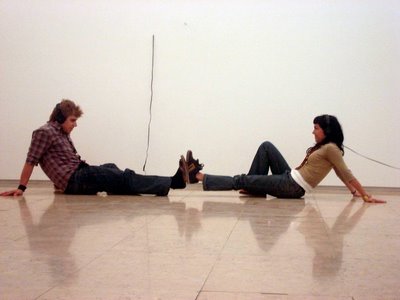|
|---|
Friday, May 12, 2006


What is an installation?
It's a tricky way of avoiding the concept of sculpture, of course.
But that's not what I mean. What I'm interested in, this time, is: what is the status of an installation. How does it work? How does it perform? Obviously, there are rules, and obviously, there are conventions, incredibly strong ones, that let (make?) you look and not touch, touch and not taste, taste and not take away, take away and not break. And I'm sure someone has been analyzing the public's interaction with the works, in the sense not only of a sociological study of behavior, but also a more subtle analysis of the way people feel about objects that are put in front of them as work, as world, as partners of a conversation. What language do we choose to speak? Isn't it different from the artist's language? And how much do we take for granted?
All this comes to mind after a field visit with my Performance students from the Espaço Evoé school. We went to an exhibition by Luisa Cunha at the still-seen-as-commercial (and horribly presented on the net) gallery Chiado8. It's true, the gallery is owned by a large insurance company (it actually appears before the name!). But some of the works they have been showing are really good stuff.
I've read about a work by Luisa Cunha called Words for Gardens some time ago. It was presented at the Sydney Biennale, and it made me jealous. It looked like a very simple, pure idea - talking to someone who is in the garden, and doing it via a stationary set of phones.
To my great surprize, I discovered the work in Lisbon has the same title. And it is clearly in a gallery space. How can you transform something that is part of a garden (from the images I figured it was really integrated in a park) (also here) into the white, cold space of a gallery? The process in itself is far from new: the land-art movement surely owes a great part of its fame to having many of the works transported (or translated) into gallery spaces. But this here was supposed to be an intimate moment of listening to someone talk about nature within nature. How can you transport that?
In a small, white room, three sets of earphones. Disappointment. So we go, and listen. The artist's voice, with a slight Portuguese accent, in English: "...You wish you could draw. You see. You see things. ... Grass. You can draw grass. On endless sheets of paper. ... Draw another intense point. Let it fade along another fading and slightly curved line projected in another direction. ..."
Can we still say this is an "about the experience of seeing"? No, or at least not quite in the same way. This is really a drastically different work. It's as if we called Rauchenberg's Erased De Kooning Drawing the same thing as the original piece. And curator Ricardo Nicolau knows what he is doing: creating tension. Now, Cunha's work seems to answer its first version: the empty space needs to be filled, imagined.
And here is my problem: I didn't imagine a thing. The space remained whiter than snow, and Cunha's words didn't sound more convincing than a radio publicity. Okay, a pleasant radio publicity.
But there were more of us. And we decided to treat the gallery space as a "stage", that is, a "framework". And, as in any good installation, new things started to appear.
The earphones were distributed - one set on every wall. Also, each set had a long cable (clearly extended). Is this already an invitation?
To us, of course, it was. We worked on the use of objects and of space, on turning the context into working material... The rule was: you can only go as far as your phones allow you. Three people are performing, the rest is watching, and they go switching until everyone has tried. We spent about an hour experimenting various possibilities (the gallery, as most galleries in Lisbon, is empty most of the day, so we were only interupted once). It really looked like a setting made on purpose for a performance. The length of the cables allowed the three listeners to meet in the middle, but not go any further.
So, if I filmed this, would this be our work, or is it implied in the installation itself? This is not just a question of authorship. This is exactly the question of what "installation" means. The girl who was working at the gallery was very happy to see us experiment, as she said the "artist meant this to be a performative piece". But would we have done anything if we weren't in a performance class? Would we even see that the people who listen are unconsciously performing? And isn't this an entirely different chapter, another theme, something that should be dealt with without the... grass? One more thing: how different is the potentiality of action from the action we made? Are the long cables enough for the installation to perform? I often wonder what the Monomads would look as an installation, and this might be one of the next projects, but the change of the performative level is just drastic. Suddenly, everything becomes suggestion and potential and imagined worlds. And it is really not about human presence. It is more about saying something or restraining from any affirmation.
On our way out, we discovered a second room, with large drawings of grass. "And you go on in all directions. Intercepting the short fading and slightly curved lines coming out of intense points planted all over." Who goes in all directions? Me?
Labels: performing, sculpture













